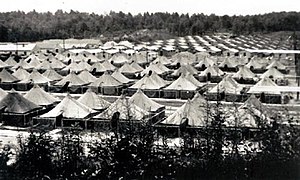| Camp Toccoa | |
|---|---|
| Stephens County, near Toccoa, Georgia | |
 | |
| Coordinates | 34°33′01″N 83°23′50″W / 34.5504°N 83.3973°WCoordinates: 34°33′01″N 83°23′50″W / 34.5504°N 83.3973°W |
| Type | Military Training Base |
| Site information | |
| Controlled by | United States |
| Site history | |
| Built | 1940 |
| In use | 1941- ca. 1946 |
Camp Toccoa was a United States Army paratrooper training camp during World War II 5 miles (8.0 km) west of Toccoa, Georgia. It was first planned in 1938, constructed by the Georgia National Guard and the Works Projects Administration beginning 17 January 1940, and was dedicated 14 December 1940. The U.S. Army took over the site in 1942.[citation needed]
World War II[]

Albert Blithe at Camp Toccoa in 1942.
The U.S. Army took over a site with few buildings or permanent structures: personnel were originally housed in tents. More permanent barracks were built as the first soldiers started to arrive. Initially, Camp Toccoa used the Toccoa municipal airport for jump training, but following a transport accident, it was abandoned for having too short a runway for safe C-39 and C-47 operations. All further jump training occurred at Fort Benning, Georgia.
Camp Toccoa also lacked a rifle range, so airborne trainees would march 30 miles (48 km) to Clemson Agricultural College, a military school in South Carolina, to practice on the college's shooting range.
The most prominent local landmark is Currahee Mountain. Paratroopers in training ran from the camp up the mountain and back, memorialized in the HBO series, Band of Brothers, with the shout "three miles up, three miles down." Members of the 506th refer to themselves as "Currahees", derived from the Cherokee word gurahiyi, which means "stand alone, together".[1] The crest is surmounted by a group of telecommunications towers.
Rod Serling, creator of the Twilight Zone, started his military career here in 1943.
After WWII[]
The camp closed at the end of the war. In the late 1940s, it served as a Georgia State Prison site, housing primarily youthful offenders, but several escapes forced the state to close the site,[citation needed] moving the operation to a new facility at Alto, Georgia. The twisting trail up Currahee is now named for Colonel Sink. The only remaining building from the camp is the mess hall, which sits on a corner of a Milliken & Company textile plant. The Patterson Pump Company occupies another portion of the grounds.
In 2012 an organization, Camp Toccoa at Currahee, a not-for profit foundation, was formed to celebrate the lives and contributions of the Airborne paratroopers who trained at Camp Toccoa at Currahee Mountain during World War II. A plan was set forth to build new facilities at the camp site and a website http://camptoccoaatcurrahee.com/ was created to promote the project.
Units trained at Toccoa[]
- 501st Parachute Infantry Regiment (501st PIR): attached to the 101st Airborne Division
- 506th PIR: attached to the 101st Airborne Division
- 507th PIR: attached to the 82nd Airborne Division and the U.S. 17th Airborne Division
- 511th PIR: attached to the 11th Airborne Division
- 517th PIR: attached to the 17th Airborne Division and the U.S. 13th Airborne Division
- 457th Parachute Field Artillery Battalion: attached to the 11th Airborne Division
- 295th Ordnance Heavy Maintenance Company (FA): completed basic training at Camp Toccoa, from July 21, 1943 through November 24, 1943.
Name change[]
The facility was initially named Camp General Robert Toombs after a Confederate Civil War General.
The story goes[citation needed] that Colonel Robert Sink, commander of the 506th Parachute Infantry Regiment, one of the first units to train there, thought that it would prompt superstitions to have young men arrive at Toccoa, travel Route 13 past the Toccoa Casket Company to learn to jump at Camp "Tombs", so he persuaded the Department of the Army to change the name to Camp Toccoa
References[]
- ↑ Curraheee Mountain in Georgia Place-Names by Kenneth K. Krakow
The original article can be found at Camp Toccoa and the edit history here.